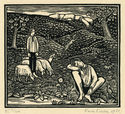
19th, 20th & 21st Century Fine Prints
707-546-7352 · fax 707-546-7924 · web: www.annexgalleries.com · email: artannex@aol.com
Karin Lieven Biography
Karin Lieven
Swiss
1899–1978
Biography
Karin Lieven, painter, printmaker, illustrator, and stamp designer, was born on 6 July 1899 in Riga, Latvia. She became a naturalized citizen of Switzerland and is referred to as Swiss.
Lieven illustrated Robin Pouceton: le dernier nain de la foret by Claude Roen in 1928 and Les histoires du vieux nain Frit-Frit by Héléne Gisiger in 1943. She also illustrated Louis Duplain’s “Perpetuite Humaine” for Editions a la Belle Etoile, Paris.
As a printmaker, Leiven worked in relief prints, engraving, and lithography and included her initial monogram into her imagery. Les Bergers is a block print from 1922; Au Café is a lithograph published in 1930 by Gabriel Mourey, Paris; and L’évasion is an engraving from 1962. Other titles include Le Jardinier, Les Vaches, and (Ploughing), the latter dates to 1933.
Karin Lieven was also a noted designer of stamps and her stamps for Switzerland were published in 1948, 1949, 1954, 1958, 1966, and 1967. The 1958 definitive set of stamps celebrating the International Bureau of Education were a joint effort by Karl Bickel, Jr. and Karin Lieven. Together they got the job of engraving the essays for the 1960 Architectural Monuments series, which would eventually be engraved by Albert Yersin.
Lieven exhibited in Paris at the Salon des Indépendants et le Salon d'Automne. She was included in the fifth exhibition Le Jeune Gravure Contemporaine at Galerie Eugène Druet, Paris in 1933. Other artists included Yves Alix, Jean-Louis Boussingault, Gérald Cochet, Etienne Cournault, Anthony Gross, Pierre Guastalia, Joseph Hecht, André Jacquemin, Léon Lang, Robert Lotiron, Roland Oudot, Mily Possoz, and Lous Joseph Soulas. In 1939, Lievin was included in a major exhibition of international women artists sponsored by the Council of Women of the United States and endorsed by the International Council on Women at the Riverside Museum in New York.
Karin Lieven died in 1978.

